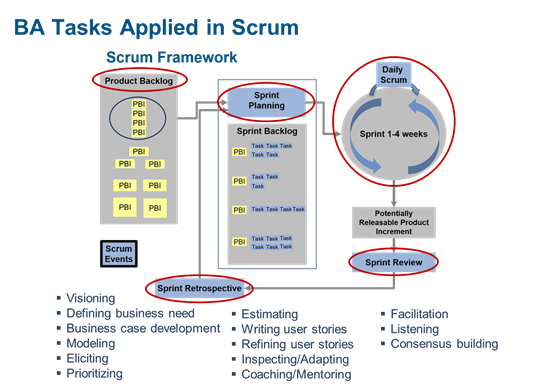Welcome to the second in a series of three blogs in which we discuss Agile Business Analysis. In our previous blog, we talked about what Agile business analysis is and the Agile mindset. In today’s blog, we will take some time to cover business analysis skills that can be leveraged in an Agile Environment.
Adding Value in Agile Environments
I often get questions from students about how business analysts can add value on Agile projects if there is no business analysis role. Overall, Agile business analysis must support an environment of creativity, rapid learning, and experimentation which leads to innovation. In addition, business analysis skills are still critical to understand the business need, maximize business value, capture and understand stakeholder requirements through user stories, model the requirements and acceptance criteria when applicable, ensure business rules and non-functional requirements are incorporated into the design, development, and testing effort, and reduce waste by maximizing the amount of work not done. They can also discover, interpret, and communicate information to increase understanding and clarity on where value can be created.
Because the business analysis role in an agile environment can vary in each organization, I have captured several ways that a business analyst can add value to an organization in an agile environment that leverage the strengths of a business analyst’s existing skills and knowledge.

Understanding the Business Need
Agile business analysis provides just enough information to decide whether to begin a new initiative. Business analysts can create value by identifying the Business Need (problem or opportunity), defining Business Requirements (goals and objectives), and enabling the organization to respond to those changing needs and achieve the business goals. Depending on the organization, the business analyst may also create or participate in building the business case that captures the business need and business requirements that may get approved and prioritized through portfolio management processes.
To assist in understanding the business need in an agile environment, a BA may use a product roadmap which is used to identify the minimum viable product, or visioning techniques to facilitate the pre-project work effort. These techniques provide the link between the organization’s strategy and the project.
Getting Started
Business analysts can also help the Product Owner (PO) prepare for upcoming Agile activities. Many organizations call this Sprint Zero if using Scrum, although Scrum purists will quickly remind us there is no such thing as a Sprint Zero. Here we are talking about the activities we need to do before beginning our formal Agile iterations, no matter what it is called by the organization.

While most POs are experts in their product and in the ass0ociated market, the BA’s expertise lies in elicitation, stakeholder collaboration, modeling, documenting, managing requirements, etc. The value a BA brings to the table at this time focuses on the coaching and mentoring of the PO in preparing for Sprint Zero.
The business analyst supports the PO creating the product r0oadmap and/or user story map, the minimum viable product definition, and the visioning statement. They can also help the PO develop an initial Product Backlog, identify and develop key user roles, and may assist with end-user workshops to elicit information needed for user stories. The business analyst may also conduct team development activities, facilitate, and agree to Team norms, help set up the team’s physical and development environments. They can support the Team with developing personas, determine the Sprint lengths, and work with stakeholders to elicit and/or write user stories.
Prepare & Refine the Product Backlog. Although the PO is responsible for the backlog, the business analyst can help the PO order, refine, and manage the Product Backlog, contribute to release and iteration planning, help elaborate acceptance criteria in preparation for the end-of-iteration review and help the Team size and estimate the product backlog items.
During Agile Iterations
Agile business analysis practitioners may use stakeholder feedback to guide the delivery process and ensure the steady delivery of value. Agile business analysis activities play a central role in learning and identifying what is truly valuable. They can clarify for whom value is created, who can contribute to the creation of value, and who else might be impacted. Further, they help the PO and Development Team make decisions about approaches, priorities, and tradeoffs to stay focused on continuous value creation in the face of constraints, differing opinions, risks, and complexity. Importantly, the need for traditional business analysis tasks, such as modeling, prototyping, tracing requirements, etc. does not necessarily go away in an Agile environment, although it may be scaled differently.
The business analyst may also step in for the PO when they are not available and recommend actions and decisions for PO’s approval. In some organizations, they may hold the role of a PO or be the PO’s proxy.
Scrum Events
In general, a business analyst can support and/or help facilitate Scrum events, facilitate feedback, and build strong stakeholder relationships. More on this in the third blog on Agile Business Analysis.
As you can see, there is a lot of room and need for a business analysis role in an Agile environment.
Continue reading for Part 3, Business Analysis Role in Scrum Events.

 New Horizons
New Horizons
 Project Management Academy
Project Management Academy
 Six Sigma Online
Six Sigma Online
 Velopi
Velopi
 Watermark Learning
Watermark Learning
 Login
Login




 New Horizons
New Horizons
 Project Management Academy
Project Management Academy
 Velopi
Velopi
 Six Sigma Online
Six Sigma Online
 Watermark Learning
Watermark Learning